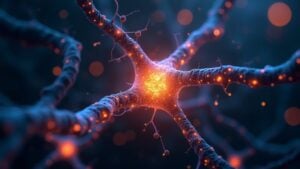Dopamine plays a huge role in how we feel and move, yet many don’t understand why it’s so paramount. This neurotransmitter starts with a simple building block—tyrosine—before transforming into a chemical that fuels motivation, pleasure, and even coordination. As dopamine levels shift, they can spark everything from intense focus to restless impulses. But what exactly occurs when this system goes off balance? The answers potentially change how you see everyday struggles—and solutions.
The Science Behind Dopamine Synthesis
Dopamine doesn’t just appear out of thin air—it’s built step by step in the brain, starting with a simple amino acid called tyrosine. This pivotal neurotransmitter forms through dopamine synthesis, a two-step process powered by enzymes.
Foremost, tyrosine hydroxylase converts tyrosine into L-dopa, relying on cofactors like tetrahydrobiopterin and iron. Next, aromatic L-amino acid decarboxylase, aided by vitamin B6, transforms L-dopa into dopamine. Most of this happens in the substantia nigra and ventral tegmental area, brain regions essential for movement and reward.
Without enough iron, vitamin B6, or tetrahydrobiopterin, dopamine production falters, potentially leading to issues like Parkinson’s disease. Comprehending this process highlights how delicate brain chemistry is—and why supporting it with proper nutrition matters.
Key Brain Pathways Utilizing Dopamine
Once synthesized, this neurotransmitter travels along specific pathways, acting like highways that connect different brain regions. The mesolimbic pathway carries dopamine from the midbrain to the limbic system, playing a crucial role in the brain’s reward system.
Another, the mesocortical pathway, extends to areas of the brain responsible for decision-making and emotions. The nigrostriatal pathway helps regulate movement, linking dopamine production to motor control. These routes guarantee messages between nerve cells are transmitted efficiently.
Dopamine release in these pathways activates dopamine receptors, influencing mood and behavior. The tuberoinfundibular pathway manages hormone secretion, showing dopamine’s broader impact. Comprehending these connections clarifies how part of the brain’s functions rely on balanced dopamine levels, shaping experiences from pleasure to movement precision. Disruptions here can alter these critical processes.
Dopamine’s Role in Reward and Motivation
The brain often relies on dopamine to make rewarding experiences feel worthwhile, pushing people to repeat actions that bring satisfaction. Dopamine plays a role in how we feel pleasure, motivation, and even focus. High levels of this chemical reinforce behaviors, making them memorable and desirable.
Low levels of dopamine, however, can lead to lack of drive or enjoyment, often seen in conditions like attention deficit hyperactivity disorder (ADHD). Some people naturally have higher or lower levels, affecting how they respond to rewards. Activities like eating favorite foods or achieving goals increase dopamine levels, creating a sense of accomplishment.
Comprehending this balance helps explain why some actions feel more rewarding than others. Proper dopamine regulation secures healthy motivation and emotional well-being.
How Dopamine Levels Affect Health and Behavior
Balanced dopamine levels keep both the mind and body running smoothly, but when they’re off, everyday life can feel like an uphill battle.
As a key brain chemical, the neurotransmitter dopamine helps people feel pleasure, control movement, and stay motivated. Low levels are linked to mental health struggles, making it hard to enjoy pleasurable activities or feel good. Too little dopamine can also cause stiffness and tremors, like in Parkinson’s disease.
On the flip side, excessive dopamine may lead to impulsive behavior or addiction as the reward and motivation system goes haywire. Small daily habits—like exercise, healthy eating, and meaningful social connections—help maintain steady dopamine levels. Recognizing these signs promptly makes it easier to take steps toward balance.
Therapeutic Uses of Dopamine in Medicine
Why is dopamine, often linked to pleasure and motivation, also a lifesaving tool in medicine? Doctors use prescription dopamine (Inotropin) to treat low blood pressure, poor cardiac output, and shock. It works by relaxing or constricting blood vessels, improving circulation.
Given intravenously, it boosts blood pressure and kidney function. However, side effects like irregular heartbeat, trouble breathing, or nausea can occur, so a full medical history is essential. Since dopamine interacts with many drugs, healthcare providers must carefully review a patient’s medication regimen.
Though dopamine levels can’t be measured directly, doctors assess symptoms to guide treatment. Its cautious use makes dopamine a powerful, yet delicate, medical ally.
Conclusion
The dopamine mechanism plays a crucial role in health, influencing everything from movement to mood. For instance, Parkinson’s patients experience tremors and stiffness due to low dopamine in the nigrostriatal pathway. Comprehending this process helps doctors prescribe targeted treatments like levodopa. By maintaining balanced dopamine levels, people can better manage conditions linked to its dysfunction, improving both mental and physical well-being. Ongoing research continues to uncover new ways to optimize its function.





